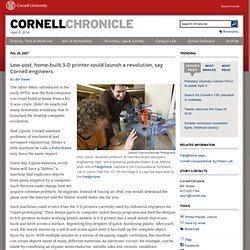

'Fabbers' could launch a revolution. Lindsay France/University Photography Hod Lipson, assistant professor of mechanical and aerospace engineering, right, and engineering graduate student Evan Malone work with a Fab@Home machine in the Computational Synthesis Lab in Upson Hall Feb. 22.

On the stage is a Lego tire duplicated by the Fab@Home. The Altair 8800, introduced in the early 1970s, was the first computer you could build at home from a kit. It was crude, didn't do much, but many historians would say that it launched the desktop computer revolution. Hod Lipson, Cornell assistant professor of mechanical and aerospace engineering, thinks a little machine he calls a Fab@Home may have the same impact. Some day, Lipson believes, every home will have a "fabber," a machine that replicates objects from plans supplied by a computer. Such machines could evolve from the 3-D printers currently used by industrial engineers for "rapid prototyping. " Lindsay France/U. "Fabbing" a Lego tire. Provided The Lego tire on the vehicle. A PC The Size of your Phone Jack?
Well, maybe it's a bit bigger than a phone jack, but this "desktop computer" is built to be installed in a wall, with cords for the mouse, the keyboard, the speakers and the monitor running out of it.

And at peak use, it only draws about five watts of power. Absolutely remarkable! The manufacturers of the Jack PC are calling it a "desktop" but it isn't quite what we think of as a computer. For one thing, it doesn't have a hard drive. So how does it work? Planet Green: Buy Green: Desktop Computers Remarkably, the Jack PC does not even require you to plug it in. More on Energy Efficient Computers7 Downloads That Turn Your PC From Energy Sucker to Energy Sipper ...Extend Your PC's Life With A Tune-Up - Planet GreenSave Energy Effortlessly with SetPower for Personalized PC Power ...Unfortunately, it will be a while before we can clear up the clutter in our own homes.
::Jade Integration ::Chip PC. Tips and downloads for getting things done. @jsim: do you really need your stuff from 1972?

Start a plan of data shredding. I have ZERO financial documents past 7 years old. It's a liability to have them longer than that. As for my flatfile Database of my Albums and cassettes I had in 1981... I dont care if it goes away. This also allows you to find the real important files and back them up. @jsim: Get a Drobo or build a FreeNAS @jsim: @Tim O'Brien: A Drobo? Smallnetbuilder.com has been a great resource for me @jsim: 1) dont let the size of the project intimidate you 2) make a list of all hard drives, internal / external, and size 3) consider WinHoSo or some other NAS software for a central source for managing all drives at the same time 4) define an external "TO" location. this is where "Files I want to keep" are going. 5) (Google) search (I. 6) run through all the other stuff deleting what you dont want and organizing what you do. 7) Have an 'end solution' for once you go through all of that data.
Ingenious DIY Idea: How to Declutter a Desk or Workspace « Dornob. It happens to the best of us: we get seduced by some sleek ultramodern furniture design and forget to factor in what it will look like when we add cables, cords and other peripherals that have become essential in this age of electronic and digital technology.

This idea solves the problem from the other direction: rather than boasting an initially simple design, it relies on your actions after-the-fact to transform a messy desk into a brilliantly clean workspace. Van Mardian may have been the first to publicize this simple DIY desk organizing idea, but many people have since (and likely before) come to the same conclusion: a simple piece of composite pegboard mounted underneath a work surface makes it easy to use wire, zip ties or whatever other fasteners you may have handy and attach all your necessary-but-ugly essentials so they are not seen from above.